The Fairfax County Park Authority is asking people to stop fighting with kites.
Last week, the park authority issued a warning about the dangers and harm caused by kite fighting, which is prohibited at county parks.
Kite fighting is an old tradition that has seen its popularity rise in recent years, partly due to the book and movie “The Kite Runner.” It’s particularly practiced in South America and a number of Asian countries, including India, Afghanistan, Bangladesh, Pakistan, Korea, and Vietnam. The main objective is to cut an opponent’s kite line before they cut yours.
But kite fighting can also be dangerous, since the already-sharp strings are sometimes coated with pieces of glass mixed with glue. Strings prepared this way can cause severe injury or, even, death. Earlier this year, sharp strings killed three children at a festival in India.
The FCPA says visitors could be banned from county parks if they repeatedly violate the kite fighting prohibition.
“The Fairfax County Park Authority has prohibited kite fighting at Fairfax County Parks, citing increasing reports of harm to wildlife, vegetation, maintenance equipment and the inherent risks to public safety,” the agency said in a press release. “Individuals observed to be kite fighting will be asked to stop. Individuals who refuse or repeatedly violate this rule may potentially be banned from park use.”
FCPA spokesperson Ben Boxer told FFXnow that kite fighting has been prohibited in county parks for “well over a year.”
However, the authority decided to issue a warning after getting complaints from community members and reports from volunteers and maintenance crews who are consistently “removing kite string/wire and debris from trees, trails and from our maintenance equipment.”
The county has received a dozen complaints from the community and volunteers in 2023, Boxer said. It also has led to increased maintenance costs with strings getting caught in mowers and other equipment.
“We’ve begun to encounter these hazards at more of our parks within the last 12 months, so this is not an isolated issue,” he said, noting that the issue isn’t confined to a specific park or area of the county.
The park authority has “seen evidence of kite fighting and received concerns from several locations,” Boxer told FFXnow.
Beyond presenting a potential danger to humans, the sharp lines can get caught on treetops and low-lying brush or end up in the water, which can be fatal to wildlife.
“Often, the kite debris and attached string are not recovered and disposed of, leaving a potentially near-invisible hazard for animals and people,” the park authority said. “Park patrons, wildlife managers and Park Authority staff are regularly documenting potential harm to birds, reptiles and other wildlife caught in kite line.”
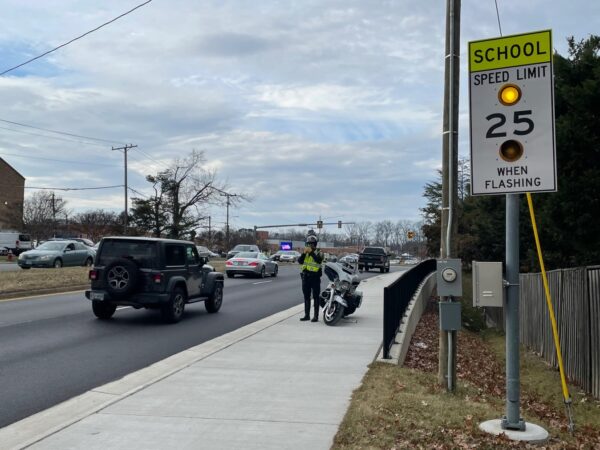
A number of new laws will take effect in Virginia this weekend, including expanded school zones, a prohibition on sexual harassment non-disclosure agreements, and classification of fentanyl as a “weapon of terrorism.”
Most laws passed by the General Assembly and signed by the governor each year go into effect on July 1, which marks the beginning of the new fiscal year.
This year, nearly 740 bills were signed into law. Some are more mundane, while others could significantly impact Fairfax County residents, like last year’s banning of ticket quotas and medical marijuana patients no longer needing to register with the state.
Here are nine noteworthy laws going into effect tomorrow (Saturday) in Virginia:
Prohibiting sexual harassment non-disclosure agreements
Introduced by local Del. Eileen Filler-Corn (D-41), HB 1895 — also known as the Silenced No More Act — prohibits any non-disclosure agreement (NDA) with the “purpose or effect of concealing the details of a sexual harassment claim.” If any such agreement does exist, it’s now “void and unenforceable,” per the new law. It mirrors recently enacted laws in other states as well as federal protections.
Assaulting a public transportation operator now leads to additional jail time
As attacks on bus drivers increase, HB 2330 now makes assaulting public transportation operators a Class 1 misdemeanor. That means a fine of up to $2,500 and up to one year in jail. The legislation, introduced by Del. Delores McQuinn of Richmond, also bans those convicted from using public transit systems.
However, critics say assailants often flee the scene prior to being arrested, suggesting the new law may not be particularly effective.
Fentanyl as “a weapon of terrorism”
Fentanyl overdoses have increasingly become a major concern, particularly among young adults, in Fairfax County and nationwide. To impose harsher penalties on the drug’s manufacturing and distribution, SB 1188 and identical bill HB 1682 reclassify fentanyl as a “weapon of terrorism,” making those acts Class 4 felonies that could carry up to 10 years of jail time.
The new law is similar to ones in other states, though critics say the law doesn’t take into account context or circumstances, and increasing penalties could make people less likely to call authorities when someone they are with overdoses.
Solicitation of a minor disqualifying for potential public school workers
Along with physical and sexual abuse, solicitation of a minor has been added as an offense that will bar someone from being employed or doing contract work for a public school, if convicted, under HB 1822.
The legislation is partially in response to last year’s conviction of a then-Fairfax County Public Schools counselor who solicited prostitution from a minor in Chesterfield. While the man was arrested in November and convicted in March, FCPS didn’t fire him until August. An investigation found Chesterfield officials didn’t notify FCPS until months after the incident. The Chesterfield Police Department claimed emails bounced back and went to spam. Read More
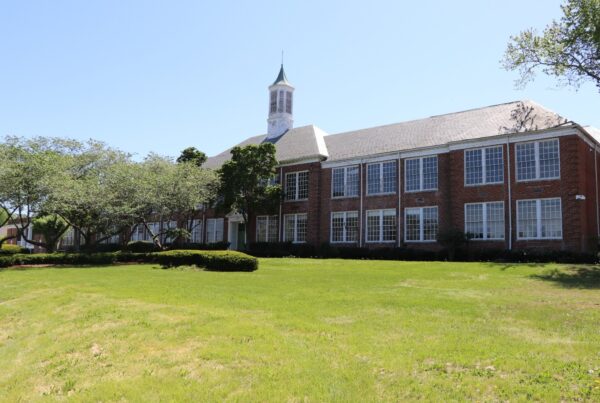
Fairfax County is looking to convert the Original Mount Vernon High School into a collection of public facilities, including possibly an early childhood center, a senior center, a performing arts space and a business incubator.
The Fairfax County Board of Supervisors is seeking a special exception amendment that will allow the county to turn the 84-year-old, now-vacated high school into an accessible public facility with a variety of proposed uses.
Potential uses listed in the application, which was filed last week, include a gym, an early childhood education center, a teen and senior center, a culinary and business incubator, visual and performing arts space, a welcome center, a commercial kitchen for education, and space for nonprofit programs focused on education, career and workforce development and financial literacy.
“Developing a cohesive facility with creative open spaces and classroom areas will nurture these coalitions and support the exchange of ideas and shared innovation,” the application says. “Design concepts will allow for flexibility and adaptability, so the spaces are changeable based on future needs.”
The special exception amendment was actually approved by the Board of Supervisors on Sept. 13, 2022, and a design and site plan are in the works, Mount Vernon District Supervisor Dan Storck reported on June 6.
However, in March, the Virginia Supreme Court struck down the county’s updated zoning ordinance, which created the “Alternative Use of Historic Buildings” category that is the basis of the proposed conversion. The ordinance has since been readopted, but the application has been resubmitted and is going through the approval process again as a precaution, Storck said.
The school’s location in the Mount Vernon District makes it ideal for a multi-use public facility, playing a “critical role” in providing educational opportunities to those in the Route 1 corridor, according to the application.
A special exception is needed to convert the 140,000 square-foot, 22-acre property at 8333 Richmond Highway due to its historical nature.
Once part of George Washington’s original estate, the school opened in early 1940 and its Colonial Revival buildings were constructed under the federal Public Works Administration program. The school was initially only open to white students, due to Jim Crow segregation that was common across Northern Virginia.
The Original Mount Vernon High School is listed on both the Virginia Historic Landmarks Register and National Register of Historic Places.
The county has been planning for its adaptive reuse since at least 2016. The facility is already hosting a renovated and reopened gym, a satellite Fire Marshal’s Office and a Fairfax County Public Schools registration site.
But the county wants to add a lot more. Under the proposal, the building would be in use for up to 17 hours a day, with the early childhood education center opening as early as 6 a.m. and the community spaces closing as late as 11 p.m.
The hope is to design the building so it can accommodate up to 2,000 people on a daily basis, per the application.
To accommodate a requirement that new additions to buildings on the Virginia Historic Landmarks Register “distinguish themselves from the existing historic building,” the welcome center would have an all-glass facade with a small section of red brick.
The application is scheduled for a planning commission public hearing on Sept. 13, which will be followed by a hearing before the Board of Supervisors on Sept. 26.
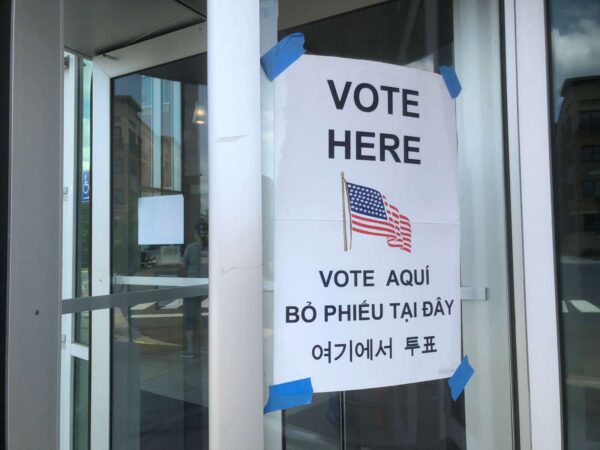
(Updated at 12:25 p.m.) Tuesday could be among the most consequential days in recent Fairfax County election history.
Tuesday, June 20 is primary election day, though early voting began in early May. While the general election is set for November, the county is overwhelmingly Democratic, so the candidates who win the primaries will be favored this fall.
With five Board of Supervisors seats, Commonwealth’s Attorney, sheriff, and a number of Virginia General Assembly seats on Tuesday’s ballot, the primary could set the course for the county for years to come.
Fairfax County Board of Supervisors
While five supervisor seats are on the primary ballot, the two open seats are getting the most attention.
Last August, Dranesville District Supervisor John Foust announced he won’t run for reelection this year, opening the door for two candidates who have emerged to take his place. Jimmy Bierman formerly chaired the Dranesville District Democratic Committee, and David Fiske is on the McLean Citizens Association board. In March, Foust endorsed Bierman for the seat.
Late last year, longtime Mason District Supervisor Penny Gross also said she will retire. Now, four candidates are vying for the vacant seat. They include Congressional staffer Jeremy Allen, Mason District Planning Commissioner Andres Jimenez, local business owner Steve Lee, and local business owner Reid Voss.
Jimenez is currently considered the frontrunner for the seat, winning a straw poll by Fairfax County Democratic Committee straw poll in March. His endorsements include actor Jane Fonda, whose political action committee also weighed in on three local General Assembly races yesterday (Thursday).
However, Voss supporters have accused him of being absent from his duties on the planning commission.
In other races, Board Chairman Jeff McKay is facing a primary challenge from retired CIA staffer Lisa Downing, while incumbent Mount Vernon District Supervisor Dan Storck is on the ballot against grassroots leader Martiza Zermeno.
In addition, two candidates are seeking the Democratic nomination to take on Springfield District Supervisor Pat Herrity in November. Herrity, the board’s only current Republican, doesn’t have a primary challenger.
County firefighter John Nowadly has a number of notable endorsements, including from McKay, Rep. Gerry Connolly and several local state senators. Local tech entrepreneur Albert Vega is endorsed by Commonwealth’s Attorney Steve Descano, who is facing his own challenge on Tuesday.
Fairfax County Commonwealth’s Attorney and Sheriff
The primary race between Descano and prosecutor-turned-defense attorney challenger Ed Nuttall for the Commonwealth’s Attorney may be the most hotly contested on this year’s ballot.
Since announcing his candidacy back in February, Nuttall has criticized how Descano manages the office as well as not appropriately supporting victims of crimes. During a joint appearance on the WAMU show The Politics Hour, Descano accused his opponent of associating with “MAGA, antisemitic conspiracy theorists,” while Nuttall responded by calling the incumbent “incompetent” and a “liar.”
The Washington Post has endorsed Nuttall, while Descano has endorsements from Connelly, Rep. Don Beyer, former governor Terry McAuliffe, and five county supervisors, per his website. He also has the support of musician John Legend.
Another notable race on the ballot is for Fairfax County sheriff, where former D.C. police officer and current Herndon High School football coach Kelvin Garcia is challenging Stacey Kincaid, the county’s first female sheriff. Read More

Fairfax County is restarting and opting into a statewide program that helps commercial properties with financing for energy efficiency and resiliency improvements.
Last week, the Fairfax County Board of Supervisors approved the amending and re-adoption of the Commercial Property Assessed Clean Energy and Resiliency (C-PACE) program, which aims to assist commercial building owners with energy and water-saving improvements for little to no upfront costs.
The county first established its own program in 2019, the first in the state to include resiliency projects that address high wind, extreme temperature and flood risks. But in the four years since, no contracts have been executed, and no projects have been completed under the program.
C-PACE is intended as a financial tool designed to “provide long-term private funding to [commercial] building owners for energy-saving and water-saving projects,” according to the county website.
A C-PACE loan is intended to be easier for the property owner to pay off, acting director of the county’s Office of Environmental and Energy Coordination (OEEC) John Morrill told FFXnow in an email.
“The intent of the energy improvements financed through a C-PACE loan is to reduce the operating costs of a property, thereby putting the property owner in a better financial position to pay off all loans,” Morrill said.
He said C-PACE “has struggled to gain traction” because of a confusing process, lack of understanding of the financial product, and the “reluctance” of first-lien debt holders to give up being first to be paid back.
At the meeting, several supervisors expressed their disappointment in the county program so far, voting unanimously to instead opt into a statewide program created in late 2021.
“It’s obviously disappointing that…we adopted a program that has not been used,” Dranesville District Supervisor John Foust said. “I think the step that you are taking us on, with aligning us with the state program, is a very positive change that could help make it more popular.”
Opting into Virginia’s version of C-PACE provides the county with two main benefits, the staff report notes. One, it relieves individual localities from procuring, administrating, and managing contracts.
“Under the statewide program, [the Virginia Department of Energy] is solely responsible for the solicitation of bids, selection of a program administrator, and contract administration,” the report says.
Secondly, it standardizes the program across jurisdictions and provides more support for messaging, engagement, and public awareness. It will also expand the types of projects eligible for loans to include stormwater management and electric vehicle infrastructure.
Morrill said the county hopes partnering with the state will help solve the challenges that the program has faced.
By standardizing application documents in the state program, attorney fees and other transaction costs for completing loans will be less expensive through the state program and result in less friction for getting deals completed. In addition, Fairfax County will work with the state energy office and C-PACE program administrator to promote the availability of C-PACE financing in order to help the market better understand this financial product. As for concern about losing first lien status, we hope consistent marketing and promotion of the program with some success stories will help give lenders confidence that C-PACE can be successful in Virginia, just as it has been in several other states.
But the county had similarly high hopes when it launched C-PACE years ago.
Mason District Supervisor Penny Gross recalled a luncheon in 2018 where the county introduced the program to local business owners. The room was full of excitement that appeared to have nothing to do with the free lunch, she said. But when the program was enacted and the application period opened, the excitement seemingly dissipated.
“I thought we’d sit back and watch the applications roll in, and nothing happened,” Gross said. “It was a great disappointment for those who worked on C-PACE.”
The county hopes local commercial business owners will now become aware of the program and its ability to provide financial help to make climate-friendly changes.
“Now there appears there is a pathway to actually make C-PACE work,” Gross said. “I’m glad the Commonwealth has determined that [the program] really needs the state to come in and assist with this.”
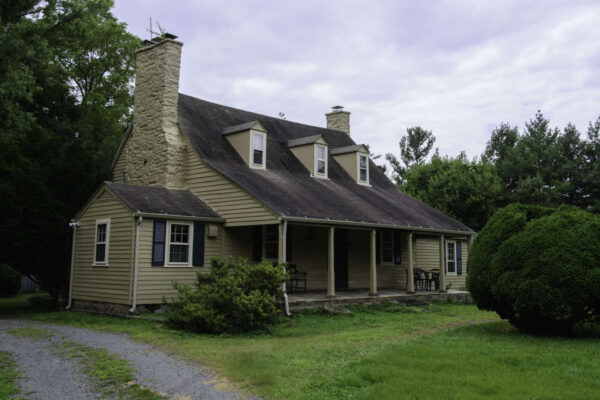
Fairfax County is beginning the process later this month of selecting the next inhabitants of the 238-year-old Mount Gilead property in Centreville.
The Fairfax County Parks Authority (FCPA) has scheduled a June 20 public Zoom meeting to discuss Mount Gilead’s inclusion in the county’s Resident Curator Program.
Under the program, the county leases out a historic property to a private citizen or nonprofit group who will occupy it long-term for free in exchange for an agreement to rehabilitate and maintain the property.
The June 20 meeting is an “introductory conversation” that will allow interested parties to get more information about what exactly the county is looking for in terms of a curator for the property, FCPA spokesperson Ben Boxer wrote FFXnow in an email.
In addition, on Saturday, June 24, there will be an in-person open house from 10 a.m. to 2 p.m. where members of the community and prospective applicants to the program can visit the property and ask questions.
Normally, Mount Gilead is only open to the public once a year during the annual Centreville Day celebration, which is being held on Oct. 14 this year.
While other properties in the program have been adapted into an adult day support center and a public park, only residential use applications will be considered for this particular property.
“Given the historical significance of this site, it was determined that residential use best befits the long-term goals of the property and the preservation of the historic integrity of the site,” Boxer told FFXnow.
Mount Gilead in Centreville was first built in 1785 as a combined residence and tavern. During the Civil War, it housed both Union and Confederate soldiers. Local lore says it was the headquarters for Confederate General Joseph E. Johnston, famed for being replaced by Robert E. Lee.
In the 1930s, ’50s, and ’60s, it underwent several notable remodelings that included additions. It has since been recorded on the Virginia Landmarks Survey, as well as in the 1969 Historic American Buildings Survey.
FCPA acquired the 6-acre property in 1996, but it has remained unoccupied ever since, with the county making continuous repairs over the last few decades.
While resident curators get to live on the property rent-free, they are responsible for all the costs associated with rehabilitation and maintenance.
A strictly-defined “treatment plan with respect to the preservation of the house itself” is determined by the county. This plan is “not open to definition by potential curators,” Boxer told FFXnow.
“Applications, including the proposed use and curator workplan, will be evaluated by a committee and to undergo a public comment period before a decision is made. The curator workplan and investment will be consistent with the requirements of the treatment plan,” Boxer continued.
Plus, the resident curator must also provide “reasonable” and “periodic” access to the public.
While there’s no timetable yet for when the county will select the next inhabitants for Mount Gilead, it did take close to four years from when plans were first submitted to new occupants moving into Herndon’s Ellmore Farmhouse.
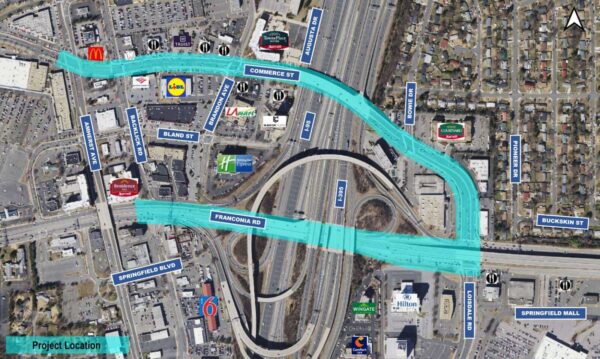
The Virginia Department of Transportation (VDOT) is asking for public input on how to reduce congestion and the number of crashes on two half-mile sections of road in Springfield.
A new survey is open through June 15, asking residents about their traveling habits and safety concerns along Franconia Road between Backlick Road and Loisdale Road. The survey also focuses on Commerce Street between Amherst Avenue and Franconia Road.
The survey marks the beginning of a STARS (Strategically Targeted Affordable Roadway Solutions) study that will help develop “proposed improvements that localities can pursue for funding,” a press release says.
Those two sections of roads, particularly Franconia Road, are of concern because they often have traffic congestion due to the nearby I-95 interchange. There’s also a high number of crashes, according to VDOT.
That half-mile section of Franconia Road averages about 69,000 vehicles a day and has had 162 crashes between January 2015 and October 2022, per a VDOT presentation. That includes at least one fatal crash and several that resulted in severe injuries.
The portion of Commerce Street in the study has much less volume, with only about 19,000 vehicles every day. But there have been even more crashes along the road during that same time period.
A large number of the 171 crashes have resulted in property damage only, but several did lead to severe injury.
VDOT is looking into a number of improvements along those roads focused on safety, the presentation notes.
That includes “innovative intersections” that have different shapes or traffic flow patterns. It could also mean adding Rectangular Rapid Flashing Beacons, high-visibility crosswalks and improved bicycle facilities, including better bicycle lane transitions and pavement markings.
What exactly will be done will, at least partially, depend on the results of the public survey, VDOT said.
In the questionnaire, respondents are asked to rank their top concerns, with traffic congestion, pedestrian safety, public transit access, and speeding among the options listed. They are also asked when they typically traveled along those roads, by what method of transportation, and when they typically experience congestion.
The survey “will be used to help develop potential safety and operational alternatives that will be evaluated and presented during the second round of public involvement scheduled for this winter,” the project website reads.
The study is set to be completed in spring 2024. No construction timeline has been set as of yet, per the press release.
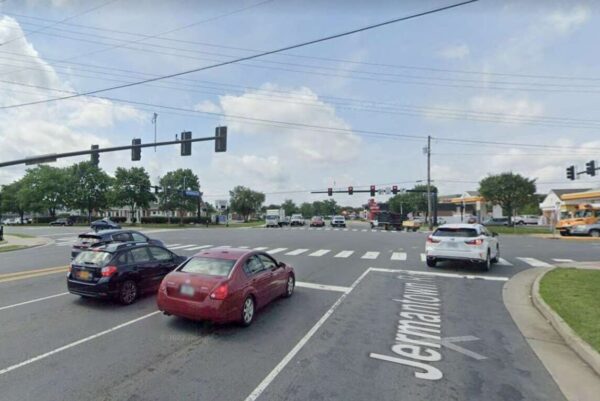
The City of Fairfax is asking the public for help in planning long-anticipated improvements to Jermantown Road.
On Wednesday (May 31) from 7-9 p.m., Fairfax will hold an open house at Katherine Johnson Middle School (3801 Jermantown Road) so the public can weigh in on preliminary design concepts for the Jermantown Road Corridor Improvement Project.
The project is set to add sidewalks, medians, and pedestrian crossings along about a mile-long section of two-lane Jermantown Road that extends from Route 50 to the city limits at the I-66 interchange. Other changes include a traffic circle at Orchard Street as well as a right-turn lane south of Orchard Street.
Also proposed are enhanced roadway crossings at Katherine Johnson Middle School and Providence Elementary School (3616 Jermantown Road), and a reduction of the number of driveways and access points along the road.
“Jermantown Road provides key local access (residential, school, & commercial locations) and connections to Fairfax County,” the project page says. “Current conditions are challenging for some users, and accommodating future growth and changes will require improvements to help the city.”
Fairfax City received $21 million from the Northern Virginia Transportation Authority to make these road improvements. There’s no timeline for when construction might begin or be completed, with the project now in the design phase.
The city first brought on engineers to provide a concept plan for the project in 2018. Two options were put on the table: a widening of all of Jermantown Road from two to four lanes or more limited “spot improvement” option. The latter prevailed.
Earlier this month, city council members got a preview of the planned improvements during a work session with city staff, including transportation director Wendy Block Sanford.
According to staff, the average daily traffic along Jermantown Road is about 14,000 vehicles a day — a relatively high number for a road of this nature. There are also more than 30 access points to the road, like entrances or driveways. Typically, access points are where more crashes occur.
The road also is home to a growing population, making pedestrian and bicycle access even more crucial. About 1,100 households either live on or within a quarter-mile of the road, per the staff presentation. In addition, about a quarter of the roughly 2,000 students who attend the two schools could walk to school if safety was improved.
As noted at the council work session, tomorrow’s open house is really the beginning of the engagement process.
“The 31st is really meant to be a kick-off and listening session,” Sanford told the city council. “We don’t have the answers yet. What we know are what some of the challenges are and we want to know more about those challenges and understand everything. There will be plenty more. This is truly the first engagement of many engagements.”
While not part of the project, but related since it connects, the Jermantown Road Bridge over I-66 is now scheduled to likely open in the fall. Previously expected to reopen this spring, the bridge is getting new sidewalks and bicycle paths.
Sanford said there are “some issues” going on between the Virginia Department of Transportation and the contractor, but the expectation is that it will open later this year.
Image via Google Maps
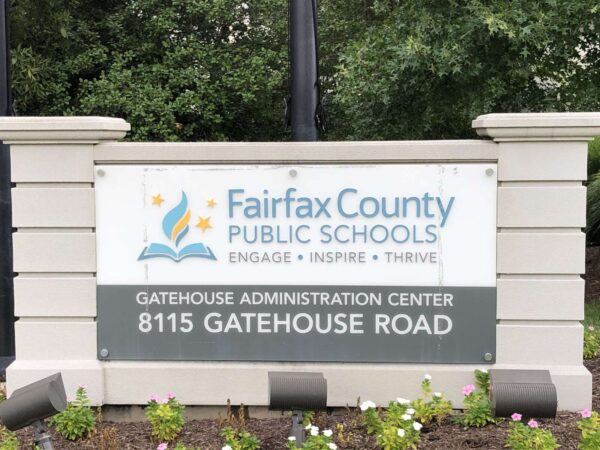
Fairfax County Public Schools is proposing some notable updates to its student policies.
At last week’s school board meeting, school officials laid out a number of proposed revisions to its Student Rights and Responsibilities handbook, including how cases of bullying are handled, what’s interpreted as appropriate clothing, and the potential for increased punishment for substance misuse.
The presentation from FCPS Assistant Auperintendent Michelle Boyd was relatively brief due a planned school board work session next week (May 23), which will likely be spent discussing the proposed dress codes updates, Providence District School Board Representative Karl Frisch noted.
Essentially, FCPS is looking to update verbiage around the dress code, which was last reviewed in 2016. The update will not include a ban on pajamas that was initially proposed earlier this year but has since been reconsidered.
Proposed language includes the dress code supporting “equitable educational access” while not reinforcing stereotypes or increasing marginalization:
FCPS’ student dress code supports equitable educational access and is written in a manner that does not reinforce stereotypes or increase marginalization or oppression of any group based on race, color, national origin, caste, religion, sex, pregnancy, childbirth, medical condition, household income, sexual orientation, gender identity, gender expression, marital status, disability, age, or genetic information.
It also clarifies that the same rules apply “regardless of the student’s age or gender” while providing examples of what isn’t allowed, including clothing that depicts or promotes use of weapons, alcohol, tobacco, or drugs.
Any violation and enforcement of the dress code will continue to be addressed in a “discreet” manner, showing respect to the student, and “minimizes loss of instructional time.”
“Violations of the dress code should generally be treated as minor infractions unless they are repeated or egregious in nature (e.g., streaking, hate speech),” the current code says.
However, this can leave much open to interpretation for school staff and administration. Several school board members noted that some language could be included to ensure a more standardized interpertation across the school system.
“I know we are trying to thread a needle here between what kids recognize as appropriate dress and not,” Springfield District School Board member Laura Jane Cohen said.
Also being proposed is a shift in what happens when there are alleged acts of bullying. The school system is now seeking to require that a principal or staff member notify a parent or guardian of every student involved in an alleged act of bullying within 24 hours of learning about the incident.
The update would also better define that bullying involves a “power imbalance” and what that could look like.
“Examples of a power imbalance include, but are not limited to, greater physical strength or size, access to embarrassing information, or greater popularity or social connectedness,” reads the updated definition.
Also proposed are updated definitions of harassment, hate speech, and hazing, along with potentially more severe punishments. For example, hazing could become a Level 5 infraction, which is the most severe and could result in law enforcement getting involved.
In addition, students with a first-time hate speech infraction would be required to participate in “culturally responsive intervention.”
FCPS is also tweaking its handling of substance misuse in response to recent incidents. While incidents involving alcohol, marijuana, and inhalants customarily result in a two-day suspension, the school principal can decide to levy even more disciplinary action if the conduct has “substantially disrupted the instructional program [or] endangered the well-being of others.”
This could mean a referral to the superintendent and a suspension of up to 10 days. There are number of other changes being asked for, including rewordings and clarity in terms of verbiage, but as Boyd said, those are “relatively minor in nature.”
After next week’s work session, a revised draft is set to be presented to the school board at the end of the month. The school board is expected to vote and adopt the updated students’ rights and responsibilities by the end of June.
Inova Mount Vernon Hospital will open a new behavioral health unit next week, marking an expansion of mental health care along the Richmond Highway corridor.
A ribbon-cutting ceremony was held yesterday morning (Tuesday) for the nearly $10 million facility, which will increase bed capacity at the hospital by 67%.
Close to $4 million was donated by Amyia and Jeff Veatch, a local entrepreneur who founded the engineering firm Apex Systems. The family previously donated money to help modernize the hospital’s emergency room.
Hospital leaders and a number of elected officials attended the ceremony, including Rep. Don Beyer, State Sen. Scott Surovell, Del. Paul Krizek, Mount Vernon District School Board Rep. Karen Corbett Sanders, and Mount Vernon District Supervisor Dan Storck (who had to leave to vote on the county budget).
The Inova Veatch Family Behavioral Health Unit will open to hospital patients on May 16. It will feature 20 additional beds, private rooms, “quiet” spaces, modernized equipment, and enhanced safety features, like impact resistance windows and drywall.
Along with the hospital’s existing adult psychiatric unit, the total capacity for behavioral health patients will now be 50 beds.
As many noted during the ceremony, mental health care and behavioral services have become a priority in Fairfax County, as rates of depression and suicidal thoughts, specifically among young people, have risen drastically in recent years.
“We have a significant shortage of mental health services all over Virginia and especially acute here in Northern Virginia,” Surovell, who represents Hybla Valley, Woodlawn, and parts of Franconia, told FFXnow. “That’s the big reason we need to expand these services. If you don’t have a place for people to go when they need help, it can result in really tragic consequences.”
He called private contributions like the one made by the Veatch family “critical” to expanding care, particularly since behavioral services “are often not the most profitable areas for a hospital to invest in.”
But he said it’s also on the state to make the necessary investments as the need for mental health care continues to skyrocket.
Virginia Gov. Glenn Youngkin has proposed $230 million in this year’s budget for addressing gaps in behavioral health services. Surovell said that doesn’t go far enough.
“This is about half of what we need because the state is so far behind in investing in behavioral health,” he said.
Mount District Supervisor Dan Storck agreed, stating at the ribbon-cutting that “we’ve never done enough” to provide mental health care both locally and across the country. Adolescent care in particular is lacking, he told FFXnow.
“We need more adolescent psychiatry units. Our adolescents are bearing the brunt of Covid,” Storck said. “They need more support than we can provide. Inova is stepping up in their Fairfax hospital, but that’s still inadequate to our adolescent needs.”
Beyer shared that his son suffers from schizophrenia and has been hospitalized “many times” at Inova Mount Vernon Hospital. The additional unit will hopefully provide care to more people in need like his son, he said.
While more resources are needed, the Veatch behavioral health unit and emergency room are potentially life savers for residents of the Richmond Highway corridor, Surovell said.
“They don’t have to travel to either Alexandria [City] or Franconia or Fairfax to get these services,” he said. “Having a facility that’s close can be the difference between life or death for a lot of people.”

